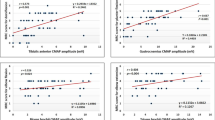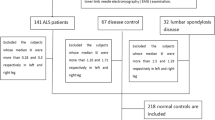Abstract
It has been suggested that corticomotoneuronal drive to ankle dorsiflexors is greater than to ankle plantar flexor muscles, despite the finding that plantar flexors are no less active than TA during walking and standing. The present study was undertaken to determine whether there was differential involvement of distal lower limb muscles in amyotrophic lateral sclerosis (ALS), to elucidate pathophysiological mechanisms of selective muscle involvement. Prospective studies were undertaken in 52 ALS patients, including clinical assessment, disease staging (revised ALS functional rating scale), Medical Research Council sum score, and a scale of upper motor neurone (UMN) dysfunction. Motor unit number estimates (MUNE) and compound muscle action potentials (CMAP) from ankle dorsiflexors and plantar flexors were used to provide objective measures. A novel ‘split leg index’ was calculated as follows: SLI = CMAPDF ÷ CMAPPF. In ALS, there was significantly greater reduction of MUNE and CMAP amplitude recorded from plantar flexors when compared to dorsiflexors, suggesting preferential involvement of plantar flexor muscles, underpinning a ‘split leg’ appearance. The SLI correlated with clinical plantar flexor strength (R= −0.56, p < 0.001). In no patient did the SLI suggest preferential dorsiflexor involvement. In subgroup analyses, mean SLI was greatest in lower limb-onset ALS. In conclusion, the present study has established dissociated involvement of muscles acting around the ankle in ALS. We suggest this reflects underlying differences in cortical, descending or local spinal modulation of these muscles.




Similar content being viewed by others
References
Ravits JM, La Spada AR (2009) ALS motor phenotype heterogeneity, focality, and spread: deconstructing motor neuron degeneration. Neurology 73(10):805–811
Simon NG, Lomen-Hoerth C, Kiernan MC (2014) Patterns of clinical and electrodiagnostic abnormalities in early amyotrophic lateral sclerosis. Muscle Nerve. doi:10.1002/mus.24244
Devine MS, Kiernan MC, Heggie S, McCombe PA, Henderson RD (2014) Study of motor asymmetry in ALS indicates an effect of limb dominance on onset and spread of weakness, and an important role for upper motor neurons. Amyotroph Lateral Scler Frontotemporal Degen. doi:10.3109/21678421.2014.906617
Wilbourn AJ (2000) The split hand syndrome. Muscle Nerve 23:138
Kuwabara S, Mizobuchi K, Ogawara K, Hattori T (1999) Dissociated small hand muscle involvement in amyotrophic lateral sclerosis detected by motor unit number estimates. Muscle Nerve 22(7):870–873
Brouwer B, Ashby P (1992) Corticospinal projections to lower limb motoneurons in man. Exp Brain Res 89(3):649–654
Ravits J, Paul P, Jorg C (2007) Focality of upper and lower motor neuron degeneration at the clinical onset of ALS. Neurology 68(19):1571–1575
Turner MR, Brockington A, Scaber J, Hollinger H, Marsden R, Shaw PJ et al (2010) Pattern of spread and prognosis in lower limb-onset ALS. Amyotroph Lateral Scler. 11(4):369–373
Brooks BR (1996) Natural history of ALS: symptoms, strength, pulmonary function, and disability. Neurology 47(4 Suppl 2):S71–S81
de Carvalho M, Dengler R, Eisen A, England JD, Kaji R, Kimura J et al (2008) Electrodiagnostic criteria for diagnosis of ALS. Clin Neurophysiol 119(3):497–503
Cedarbaum JM, Stambler N, Malta E, Fuller C, Hilt D, Thurmond B et al (1999) The ALSFRS-R: a revised ALS functional rating scale that incorporates assessments of respiratory function. BDNF ALS Study Group (Phase III). J Neurol Sci 169(1–2):13–21
Medical Research Council (1976) Aid to the examination of the peripheral nervous system. Her Majesty’s Stationary Office, London
Simon NG, Lin CS-Y, Lee M, Howells J, Vucic S, Burke D et al (2014) Segmental motoneuronal dysfunction is a feature of amyotrophic lateral sclerosis. Clin Neurophysiol. doi:10.1016/j.clinph.2014.07.029
Lin CS, Chan JH, Pierrot-Deseilligny E, Burke D (2002) Excitability of human muscle afferents studied using threshold tracking of the H reflex. J Physiol 545(Pt 2):661–669
Blok JH, Ruitenberg A, Maathuis EM, Visser GH (2007) The electrophysiological muscle scan. Muscle Nerve 36(4):436–446
Ridall PG, Pettitt AN, Henderson RD, McCombe PA (2006) Motor unit number estimation—a Bayesian approach. Biometrics 62(4):1235–1250
Henderson RD, Ridall PG, Hutchinson NM, Pettitt AN, McCombe PA (2007) Bayesian statistical MUNE method. Muscle Nerve 36(2):206–213
Morse CI, Tolfrey K, Thom JM, Vassilopoulos V, Maganaris CN, Narici MV (2008) Gastrocnemius muscle specific force in boys and men. J Appl Physiol (1985) 104(2):469–474
Mitchell JD, Borasio GD (2007) Amyotrophic lateral sclerosis. Lancet 369:2031–2041
Twitchell TE (1951) The restoration of motor function following hemiplegia in man. Brain 74(4):443–480
Stewart JD (2008) Foot drop: where, why and what to do? Pract Neurol 8:158–169
Lunsford BR, Perry J (1995) The standing heel-rise test for ankle plantar flexion: criterion for nornal. Phys Ther 75:694–698
Scarmeas N, Shih T, Stern Y, Ottman R, Rowland LP (2002) Premorbid weight, body mass, and varsity athletics in ALS. Neurology 59:773–775
Liu MQ, Anderson FC, Pandy MG, Delp SL (2006) Muscles that support the body also modulate forward progression during walking. J Biomech 39(14):2623–2630
Courtine G, Papaxanthis C, Schiepatti M (2006) Coordinated modulation of locomotor muscle synergies constructs straight ahead and curvilinear walking in humans. Exp Brain Res 170:320–335
Eisen A, Kuwabara S (2012) The split hand syndrome in amyotrophic lateral sclerosis. J Neurol Neurosurg Psychiatry 83(4):399–403
Eisen A, Kim S, Pant B (1992) Amyotrophic lateral sclerosis (ALS): a phylogenetic disease of the corticomotoneuron? Muscle Nerve 15:219–224
Weber M, Eisen A, Stewart H, Hirota N (2000) The split hand in ALS has a cortical basis. J Neurol Sci 180:66–70
Voermans NC, Schelhaas HJ, Munneke M, Zwarts MJ (2006) Dissociated small hand muscle atrophy in aging: the ‘senile hand’ is a split hand. Eur J Neurol 13:1381–1384
Bae JS, Sawai S, Misawa S, Kanai K, Isose S, Kuwabara S (2009) Differences in excitability properties of FDI and ADM motor axons. Muscle Nerve 39(3):350–354
Hudson HM, Griffin DM, Belhaj-Saif A, Cheney PD (2013) Cortical output to fast and slow muscles of the ankle in the rhesus macaque. Front Neural Circuit 7:33
Brouwer B, Ashby P (1990) Corticospinal projections to upper and lower limb spinal motoneurons in man. Electroencephalogr Clin Neurol. 76(6):509–519
Valls-Sole J, Alvarez R, Tolosa ES (1994) Responses of the soleus muscle to transcranial magnetic stimulation. Electroencephalogr Clin Neurol 93(6):421–427
Menon P, Bae JS, Mioshi E, Kiernan MC, Vucic S (2013) Split-hand plus sign in ALS: differential involvement of the flexor pollicis longus and intrinsic hand muscles. Amyotroph Lateral Scler Frontotemporal Degen 14(4):315–318
Bae JS, Menon P, Mioshi E, Kiernan MC, Vucic S (2013) Cortical excitability differences between flexor pollicis longus and APB. Neurosci Lett 29(541):150–154
Bae JS, Menon P, Mioshi E, Kiernan MC, Vucic S (2014) Cortical hyperexcitability and the split-hand plus phenomenon: pathophysiological insights in ALS. Amyotroph Lateral Scler Frontotemporal Degen 15(3–4):250–256
Menon P, Kiernan MC, Vucic S (2014) Cortical excitability differences in hand muscles follow a split-hand pattern in healthy controls. Muscle Nerve 49(6):836–844
Menon P, Kiernan MC, Vucic S (2014) Cortical dysfunction underlies the development of the split-hand in amyotrophic lateral sclerosis. PLoS One 9(1):e87124
Turner MR, Kiernan MC (2012) Does interneuronal dysfunction contribute to neurodegeneration in amyotrophic lateral sclerosis? Amyotroph Lateral Scler 13(3):245–250
Swash M (2012) Why are upper motor neuron signs difficult to elicit in amyotrophic lateral sclerosis? J Neurol Neurosurg Psychiatry 83(6):659–662
Walshe FMR (1914) The physiological significance of the reflex phenomena in spastic paralysis of the lower limbs. Brain 37:269–336
Isa T, Kinoshita M, Nishimura Y (2013) Role of direct vs. indirect pathways from the motor cortex to spinal motoneurons in the control of hand dexterity. Front Neurol 4:191
Zaaimi B, Edgley SA, Soteropoulos DS, Baker SN (2012) Changes in descending motor pathway connectivity after corticospinal tract lesion in macaque monkey. Brain 135:2277–2289
Acknowledgments
Dr. Simon gratefully acknowledges funding from the National Health and Medical Research Council of Australia and the Motor Neurone Disease Research Institute of Australia (grant #1039520). This work was supported by funding to Forefront, a collaborative research group dedicated to the study of motor neurone disease, from the National Health and Medical research Council of Australia Program Grant (#1037746). We are grateful to the research participants involved with the ForeFront research studies. Preliminary results from this study were presented in abstract form at the American Academy of Neurology Annual Meeting, San Diego, CA, March 21, 2013: Simon N, Bae JS, Mioshi E, Lin C, Vucic S, Kiernan M. The split leg in amyotrophic lateral sclerosis. Neurology February 12, 2013; 80 (Meeting Abstracts 1): P07.083.
Conflicts of interest
On behalf of all authors, the corresponding author states that there is no conflict of interest.
Author information
Authors and Affiliations
Corresponding authors
Rights and permissions
About this article
Cite this article
Simon, N.G., Lee, M., Bae, J.S. et al. Dissociated lower limb muscle involvement in amyotrophic lateral sclerosis. J Neurol 262, 1424–1432 (2015). https://doi.org/10.1007/s00415-015-7721-8
Received:
Revised:
Accepted:
Published:
Issue Date:
DOI: https://doi.org/10.1007/s00415-015-7721-8




